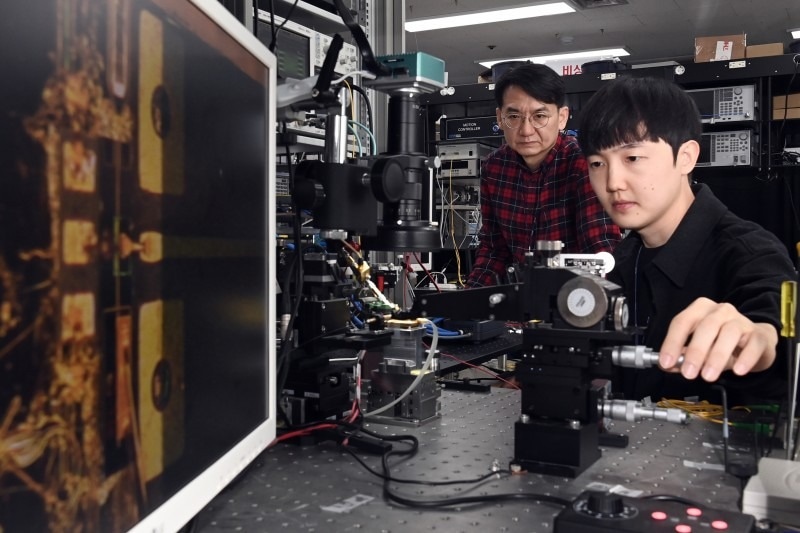Researchers at ETRI have led the way in creating light source devices that are applicable to 5G/6G mobile communication base stations as well as mega/hyper datacenters. The research team’s innovative method can transfer 5 GB full HD videos at 5.6 frames per second.

ETRI Develops Revolutionary Light Source Device to Address Data Explosion. Image Credit: Electronics and Telecommunications Research Institute
The Electro-Absorption Modulated Laser (EML) light source device technology is being independently developed, according to the Electronics and Telecommunications Research Institute (ETRI). This device is incredibly small, measuring less than a mm (0.2 mm × 0.85 mm), yet it can transport 224 Gbps optical communications per channel in data center internal networks.
From design to production, the research team used indigenous technology to construct the EML light source device, which is integrated with a photonic mode converter and a monitoring photodetector.
The designed light source device will be integrated into the tower racks of sizable data centers after it is made commercially available. These light source components which are essentially placed into the line cards inside the tower racks will be used in the transmission portion of optical transceivers, or optical transmitter and receiver modules.
A single linecard typically consists of 32 optical transceivers with 224 Gbps × 8 channels, with several line cards installed on the tower racks.
The researchers stressed the need to develop chips at the chip level, which is a fundamental piece of foundational technology, rather than just modules. They hope to dominate the world market for optical communications by creating the essential technologies for the light source chip.
Ultra-fast light source technology was required for transmission in intra-datacenters due to the rise in data utilization in Virtual Reality (VR), Augmented Reality (AR), Over The Top (OTT), Artificial Intelligence (AI), and other platforms. Larger modulation bandwidths and data processing capacities would be made available by this technology, allowing for the implementation of more significant and reasonably priced optical modules.
With Electro-Absorption Modulated Laser (EML) light source devices, conventional optical transceivers used inside intra-datacenters could transfer up to 100 Gbps optical signals per channel.
The world's best EML light source, created by ETRI, has the capacity to send 224 Gbps optical signals per channel. This device doubles the modulation bandwidth and data processing capability.
Furthermore, the 224 Gbps EML light source device has a unique integration of a photonic mode converter to improve optical coupling efficiency and a photodetector for real-time light output intensity monitoring for the first time in the world.
By including a mode converter, the coupling efficiency with optical waveguides has been raised from the current 50% to 85%, resulting in a significant improvement in optical coupling efficiency. This development also makes it possible for optical transceivers to use less energy and electricity.
In addition, compared to the traditional structure using separate photodetectors, the integration of a photodetector for monitoring optical output intensity has enabled significant cost savings in packaging for the fabrication of 800-Gbps/1.6-Tbps class optical modules as well as single-channel optical modules.
With a modulation bandwidth of 70 GHz at 70 °C, the research team created an electro-absorption modulated laser (EML) device that can operate at 224 Gbps, exhibiting a performance that leads the globe. Even at 70 °C, this device has remarkable performance, allowing 224-Gbps optical signal transmission over a distance of 2 km.
Only a few companies globally are currently developing the 224-Gbps class EML device. The research team believes that as this technology advances, there will be less need for imports from elsewhere.
Additionally, it is projected that the 800-Gbps/1.6-Tbps optical modules will be more cost- and technologically-competitive due to the integration of the photonic mode converter and the monitoring photodetector.
ETRI stated that this research accomplishment was made possible by their groundbreaking work in the field of laser diode technology, which is used to create light sources, as well as by the core source technologies they have amassed in their research and development foundry for compound semiconductor optical devices.
We have contributed to securing the competitiveness of the domestic optical device and component industry by becoming the first global pioneer to develop key technologies applicable to the rapidly evolving datacenter and 5G/6G markets.
Dr. Yong-soon Baek, Senior Vice President, Terrestrial & Non-Terrestrial Integrated Telecommunications Research Laboratory, Electronics and Telecommunications Research Institute
Dr. Young-Tak Han said, “For compound semiconductor optical devices, which are highly sensitive to processing variables, the most critical factors are securing core technologies and ensuring stable foundry operations. We have managed to address these issues by developing key technologies.”
He is also the Principal Researcher and Project Leader at ETRI’s Optical Communication Components Research Section.
The created light source technology has been the basis for both domestic and international patent applications filed by the research team. Additionally, they intend to convey this knowledge to domestic optical component manufacturers so that they may compete with multinational firms in the 5G, 6G, and data center industries.
The size of the global market for optical transceivers is expected to more than triple, from $6 billion in 2019 to $18 billion by 2026, according to market research firm LightCounting.
Furthermore, this invention was presented by the ETRI research team at OFC 2023, the world's largest optical communication conference, which took place in San Diego, USA, in March of the previous year. The technology received a lot of praise once it was published in the international SCI journal in the field of optical communications.